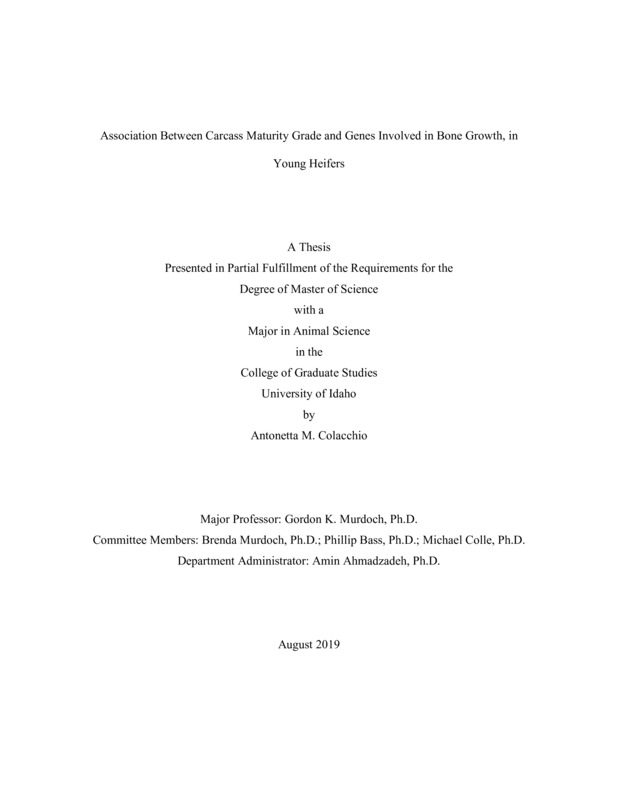Association Between Carcass Maturity Grade and Genes Involved in Bone Growth, in Young Heifers
Colacchio, Antonetta. (2019-05). Association Between Carcass Maturity Grade and Genes Involved in Bone Growth, in Young Heifers. Theses and Dissertations Collection, University of Idaho Library Digital Collections. https://www.lib.uidaho.edu/digital/etd/items/colacchio_idaho_0089n_11646.html
- Title:
- Association Between Carcass Maturity Grade and Genes Involved in Bone Growth, in Young Heifers
- Author:
- Colacchio, Antonetta
- Date:
- 2019-05
- Embargo Remove Date:
- 2021-03-03
- Keywords:
- Cattle Genes Ossification osteogenesis sequencing
- Program:
- Animal and Veterinary Science
- Subject Category:
- Animal sciences; Genetics; Physiology
- Abstract:
-
Over the last several decades, there has been an increase in the number of heifers, under 30 months of age chronologically, categorized as B and C-maturity based upon skeletal maturity at harvest. The hypothesis for this project is that heifers with advanced physiological maturity have differences within genes that encode proteins involved in bone ossification. Specifically, the genetic variance within genes that promote advanced rates of ossification relating to bone growth and extracellular matrix mineralization have resulted in young heifers reflecting maturity grades more representative of cattle over 30 months of age. This can result in substantial economic losses for producers since the value of an A-maturity carcass is as much as $350/head greater than when an animal is graded below a B-maturity. Despite the USDA change to allow use of dentition to assess maturity, there are still losses with deduction costs associated with advanced maturity in chronologically young beef cattle. In this study, we assessed eight candidate genes known to play an important role in osteogenesis, for sequence variation linkage to advanced maturity. We used targeted gene capture followed by sequencing for candidate genes, in commercial cattle graded as A, B, and C maturity groups (N=90 heifers) but confirmed to be under 30 months using records and dentition. We identified novel and significant genetic sequence variations in association with maturity score within the alkaline phosphatase (ALPL), estrogen receptor 1 (ESR1), estrogen receptor 2 (ESR2), collagen type X alpha 1 (COL10A1), and parathyroid hormone like protein (PTHLH). This represents the first report of such associations with this phenotype and could lead to opportunities to genetically screen beef cattle for susceptibility for early skeletal maturity.
- Description:
- masters, M.S., Animal and Veterinary Science -- University of Idaho - College of Graduate Studies, 2019-05
- Major Professor:
- Murdoch, Gordon K
- Committee:
- Murdoch, Brenda; Bass, Phil; Colle, Michael
- Defense Date:
- 2019-05
- Identifier:
- Colacchio_idaho_0089N_11646
- Type:
- Text
- Format Original:
- Format:
- application/pdf
- Rights:
- In Copyright - Educational Use Permitted. For more information, please contact University of Idaho Library Special Collections and Archives Department at libspec@uidaho.edu.
- Standardized Rights:
- http://rightsstatements.org/vocab/InC-EDU/1.0/

